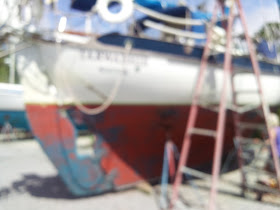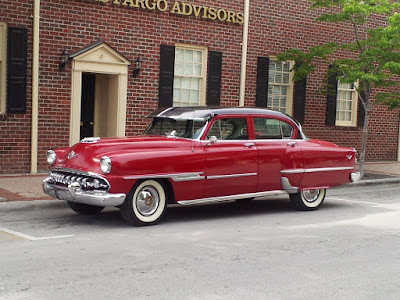Sailcraft Boatyard, Oriental, NC
35 01.97 N 076 41.11 W
I depart here from my normal blogging style to repeat verbatim one of the most amazing boating stories I ever heard. I found it
here. Charlotte, NY is on Lake Ontario.
U.S. Coast Guard Awards
George N. Gray
Frank B. Chapman
W. Vernon Downing
Charles Eastwood
Mial E. Eggleston
George E. Henderson
Ira S. Palmer
Delbert Rose
Lester D. Seymour
Awarded 3 January 1903
In recognition of their gallant conduct in effecting the rescue on 15 December 1902 of four men and one woman from the wreck of the schooner John R. Noyes, the crew of the life-saving station at Charlotte, NY received the Gold Lifesaving Medal. Those awarded included Keeper George N. Gray and Surfmen Frank B. Chapman, W. Vernon Downing, Charles Eastwood, Mial E. Eggleston, George E. Henderson, Ira S. Palmer, Delbert Rose, and Lester D. Seymour.
The circumstances of the case were as follows. About 5:30 PM on 14 December 1902, the train master of the New York Central Railroad at Charlotte, NY received a telegram requesting him to notify Keeper Gray that a vessel showing signals of distress lay at anchor about 3 miles off Lakeside, 23 miles from Charlotte. Upon receipt of the information, the keeper instantly prepared to go to her relief.
The harbor tug was frozen in the ice upriver and could not tow the surfboat to the scene. While trying to pull 23 miles against a head sea on a winter night would have been both useless and foolhardy. The keeper, therefore, resolved to proceed by rail to Lakeside and thence, if possible, to reach the vessel. He promptly secured orders for a special train at Windsor Beach and a gang of shovelers went to work breaking out two flat cars standing on a siding. Due to the deep snow and other obstructions, it was nearly two hours before the life-saving crew could get to the depot with the wagon carrying a surfboat. It would be an hour more before the train was ready.
Before leaving the station the keeper sent a telegram to the keeper of the Oswego Station. He requested him to dispatch a tug in search of the craft in order to save her. He also telegraphed Lakeside for teams to be in readiness for his use at that point. The special train was delayed by a freight train and Lakeside was not reached until 9:35 PM. From there the condition of the roads proved so unfavorable that sleds were necessary to transport the apparatus to the shore.
The journey of 4 miles was extremely difficult. There were great snowdrifts, at least 6 feet deep, obstructing progress. There were also very considerable stretches swept bare, over which it was impossible for four horses to drag the sleds. The crew was frequently compelled to assist in hauling them. At 11:30 PM the shore was gained and while the boat was being removed from the sleds. With the hope that it might encourage the distressed vessel’s crew, the keeper proceeded to a bluff and burned a red Coston signal. Before embarking, he also obtained as good an idea of her position as he could get.
Launching the boat, the crew pulled outside into the heavy sea. The weather, however, was bitter cold. The air was so thick with vapor that the keeper, after going about a mile, found it impossible to see a dozen yards ahead. Nevertheless, he kept on by compass until about 3:00 AM. For three and one-half hours they fruitlessly continued the search, burning several Coston signals. Finally, with the bewilderment so disheartening, he felt compelled to wait for daylight and ordered the boat ashore. At his request the people of the vicinity built a large bonfire, which it was hoped might possibly be seen from the vessel. All hands were permitted to lie down for 90 minutes. After breakfast the keeper sent the entire crew along the cliffs in order to sight the vessel, if possible, after daybreak. No signs of her, however, were discovered. Leaving a man on shore with instructions to ascend to the top of a windmill and signal which way the boat should go, again he launched the surfboat.
As soon as the lookout reached the top of the mill, he discovered the schooner in the distance. Upon his signal the keeper put back into the beach. He then spotted the vessel with the aid of marine glasses. Taking note of her bearings by the compass, he again launched. Having the wind astern, the boat soon made a distance of 10 miles off shore when the wind came brisk from the east. This compelled him to proceed in the dangerous trough of the combing waves. The weather was so cold that the spray rapidly covered the boat and its occupants with ice. The conditions then constantly grew more difficult and when the boat reached the wreck at 11:30 AM, 20 miles off shore, the wind was blowing very hard and the sea was running high.
The vessel and her crew were in a most pitiful condition. She had lost her sails, yawl boat, and both anchors, had her cabin smashed in. She was leaking fast and was heavily encumbered with ice. She was simply a helpless wreck, drifting about at the mercy of the storm. All on board were suffering from exposure for more than fifty hours and from lack of food for upward of thirty-six hours. They had lost hope, bidden one another goodbye, and were lying on the deck benumbed. Some were hysterical. In a little while all would have perished.
Having wrapped the woman in the keeper’s overcoat and provided her with mittens, the lifesavers managed to place all hands safely into the surfboat. As nothing could be done to save the wreck, the keeper pushed off quickly with a view of gaining the land before darkness should shut down. All were worn out and the return trip lay in the trough of the sea. This made it necessary to head the boat up to the breakers, whereby her progress was much impeded. A little assistance was rendered at the oars by some of the shipwrecked men when they were sufficiently recovered. After an extremely trying experience the shore was reached about 4:30 PM a mile and a half from the launching place.
On account of the accumulation of ice, however, the boat could not land. The crew was compelled to carry the rescued persons ashore, through the water and ice, on their shoulders. Then they pulled farther down, where horses dragged the boat ashore. After partaking of a warm supper, the crew proceeded with the boat to Lakeside and thence, by train, to Windsor Beach. They arrived at the starting point about 9:30 PM on 15 December. Having been engaged in this extremely hazardous enterprise more than a day and a night with little sleep, they were under oars from 11:30 PM of the 14th to 4:30 PM. of the 15th with the exception of about two hours. They pulled in a heavy seaway nearly or quite 60 miles and all were more or less frostbitten. Grave apprehensions existed on shore lest they be lost. Preparations were, in fact, made to send out a rescue party if necessary. Throughout all these trying circumstances they nobly bore their part.





































